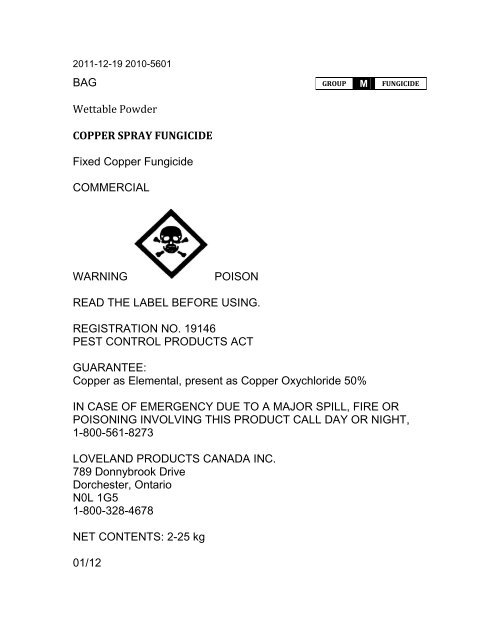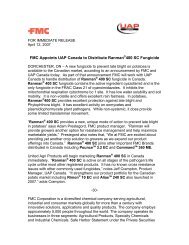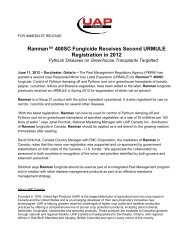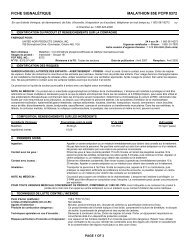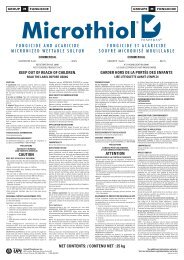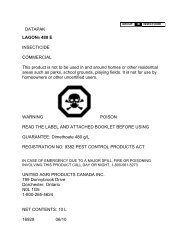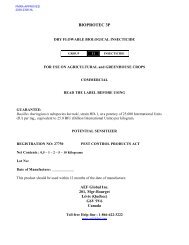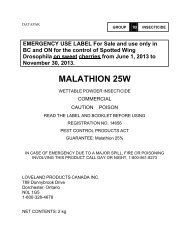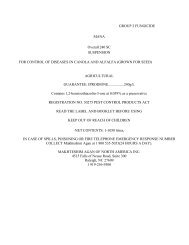BAG Wettable Powder COPPER SPRAY FUNGICIDE Fixed ... - UAP
BAG Wettable Powder COPPER SPRAY FUNGICIDE Fixed ... - UAP
BAG Wettable Powder COPPER SPRAY FUNGICIDE Fixed ... - UAP
You also want an ePaper? Increase the reach of your titles
YUMPU automatically turns print PDFs into web optimized ePapers that Google loves.
2011-12-19 2010-5601<br />
<strong>BAG</strong><br />
GROUP M <strong>FUNGICIDE</strong><br />
<strong>Wettable</strong> <strong>Powder</strong><br />
<strong>COPPER</strong> <strong>SPRAY</strong> <strong>FUNGICIDE</strong><br />
<strong>Fixed</strong> Copper Fungicide<br />
COMMERCIAL<br />
WARNING<br />
POISON<br />
READ THE LABEL BEFORE USING.<br />
REGISTRATION NO. 19146<br />
PEST CONTROL PRODUCTS ACT<br />
GUARANTEE:<br />
Copper as Elemental, present as Copper Oxychloride 50%<br />
IN CASE OF EMERGENCY DUE TO A MAJOR SPILL, FIRE OR<br />
POISONING INVOLVING THIS PRODUCT CALL DAY OR NIGHT,<br />
1-800-561-8273<br />
LOVELAND PRODUCTS CANADA INC.<br />
789 Donnybrook Drive<br />
Dorchester, Ontario<br />
N0L 1G5<br />
1-800-328-4678<br />
NET CONTENTS: 2-25 kg<br />
01/12
PRECAUTIONS: KEEP OUT OF REACH OF CHILDREN.<br />
Hazardous if swallowed, inhaled or absorbed through the skin. Avoid breathing<br />
dust or spray mist. Avoid contact with eyes, skin and clothing.<br />
Wear goggles, long pants, a long-sleeved shirt and shoes plus socks during<br />
mixing/loading, application, clean-up and repair. In addition, wear chemicalresistant<br />
gloves during mixing/loading, clean-up and repair.<br />
Remove personal protective equipment immediately after handling this product.<br />
Wash the outside of gloves before removing. As soon as possible, wash<br />
thoroughly and change into clean clothing.<br />
Remove clothing/personal protective equipment immediately if pesticide gets<br />
inside. Then wash thoroughly and put on clean clothing.<br />
Discard clothing and other absorbent material that have been drenched or<br />
heavily contaminated with the product’s concentrate. Do not reuse them.<br />
For cleaning/maintaining personal protective equipment, use detergent and hot<br />
water. Keep and wash personal protective equipment separately from other<br />
laundry.<br />
Wash hands before eating, drinking, chewing gum, using tobacco or using the<br />
toilet.<br />
DO NOT enter or allow worker entry into treated areas during the restricted-entry<br />
interval of 48 hours.<br />
For greenhouse use:<br />
DO NOT enter or allow worker entry into treated areas during the restricted-entry<br />
interval of 24 hours.<br />
At least one container or station designed specifically for flushing eyes must be<br />
available, and in operating condition with decontamination supplies, for workers<br />
entering the treated area. This container/station must remain available for at least<br />
seven days following application.<br />
Applicators must post warning signs bearing the following information on all<br />
entrances to the greenhouse:<br />
- The name of the product applied.<br />
- The date and time of the application.<br />
- “Product residues in the treated area may be highly irritating to the eyes.”<br />
- “Avoid contact of product residues with eyes.”<br />
- “If in eyes: Hold eye open and rinse slowly and gently with water for 15–20<br />
minutes using the eye flush container [or eye flush station] located in the
greenhouse. Remove contact lenses, if present, after the first 5 minutes, then<br />
continue rinsing eye. Call a poison control centre or doctor for treatment advice.”<br />
- The location of the eye flush container/station.<br />
- Instructions on how to operate the eye flush container/station.<br />
Signs must remain posted at least 7 days after treatment. Only the applicator(s)<br />
(or someone under their supervision) may remove warning signs.<br />
Do not apply or allow drift to areas occupied by unprotected persons and<br />
animals, or to streams, lakes or ponds to protect wildlife. Avoid contamination of<br />
feed or food, including such crops on which residue is unsafe.<br />
Add Hydrated lime when treating copper sensitive crops.<br />
If this pest control product is to be used on a commodity that may be exported to<br />
the U.S. and you require information on acceptable residue levels in the U.S.,<br />
visit CropLife Canada’s website at: www.croplife.ca.<br />
FIRST AID:<br />
IF ON SKIN OR CLOTHING: Take off contaminated clothing. Rinse skin<br />
immediately with plenty of water for 15-20 minutes. Call a poison control centre<br />
or doctor for treatment advice.<br />
IF IN EYES: Hold eye open and rinse slowly and gently with water for 15-20<br />
minutes. Remove contact lenses, if present, after the first 5 minutes, then<br />
continue rinsing eye. Call a poison control centre or doctor for treatment advice.<br />
IF SWALLOWED: Call a poison control centre or doctor immediately for<br />
treatment advice. Have person sip a glass of water if able to swallow. Do not<br />
induce vomiting unless told to do so by a poison control centre or doctor. Do not<br />
give anything by mouth to an unconscious person.<br />
IF INHALED: Move person to fresh air. If person is not breathing, call 911 or an<br />
ambulance, then give artificial respiration, preferable by mouth-to-mouth, if<br />
possible. Call a poison control centre or doctor for treatment advice.<br />
Take container, label or product name and Pest Control Product Registration<br />
Number with you when seeking medical attention.<br />
TOXICOLOGICAL INFORMATION: Treat symptomatically.<br />
RESISTANCE MANAGEMENT RECOMMENDATIONS<br />
For resistance management, please note that <strong>COPPER</strong> <strong>SPRAY</strong> Fungicide<br />
contains a Group M fungicide. Any fungal population may contain individuals<br />
naturally resistant to <strong>COPPER</strong> <strong>SPRAY</strong> Fungicide and other Group M fungicides.<br />
A gradual or total loss of pest control may occur over time if these fungicides are<br />
used repeatedly in the same fields. Other resistance mechanisms that are not<br />
linked to site of action but specific for individual chemicals, such as enhanced<br />
metabolism, may also exist. Appropriate resistance-management strategies<br />
should be followed.<br />
To delay fungicide resistance:
• Where possible, rotate the use of <strong>COPPER</strong> <strong>SPRAY</strong> Fungicide or other<br />
Group M fungicides with different groups that control the same pathogens.<br />
• Use tank mixtures with fungicide from a different group when such use is<br />
permitted.<br />
• Fungicide use should be based on an IPM program that includes scouting,<br />
historical information related to pesticide use and crop rotation and<br />
considers cultural, biological and other chemical control practices.<br />
• Monitor treated fungal populations for resistance development.<br />
• If disease continues to progress after treatment with this product, do not<br />
increase the use rate. Discontinue use of this product and switch to<br />
another fungicide with a different target site of action, if available.<br />
Contact your local extension specialist or certified crop advisors for any<br />
additional pesticide resistance-management and/or IPM recommendations for<br />
specific crops and pathogens.<br />
For further information and to report suspected resistance, contact the Technical<br />
Service, Loveland Products Canada Inc., 1-800-328-4678 or at www.uap.ca.<br />
DIRECTIONS FOR USE: Apply in sufficient water for thorough coverage of all<br />
plant parts; this volume depends on spray equipment and size of plants. The<br />
spray tank should be partially filled with water and the required Copper Spray<br />
Fungicide added while stirring. Keep agitating during filling and spraying<br />
operations. May be used up to 1 day before harvest or as otherwise noted.<br />
DO NOT APPLY BY AIR.<br />
DO NOT apply this product in a way that will contact workers or bystanders,<br />
either directly or through drift. Only protected handlers may be in the area during<br />
application.<br />
DO NOT apply this product directly to freshwater habitats (such as lakes, rivers,<br />
sloughs, ponds, prairie potholes, creeks, marshes, streams, reservoirs and<br />
wetlands), estuarine/marine habitats.<br />
DO NOT contaminate irrigation or drinking water supplies or aquatic habitats by<br />
cleaning of equipment or disposal of wastes.<br />
Buffer zones<br />
Field sprayer application: DO NOT apply during periods of dead calm. Avoid<br />
application of this product when winds are gusty. DO NOT apply with spray<br />
droplets smaller than the American Society of Agricultural Engineers (ASAE)<br />
medium classification. Boom height must be 60 cm or less above the crop or<br />
ground.<br />
Airblast application: DO NOT apply during periods of dead calm. Avoid<br />
application of this product when winds are gusty. DO NOT direct spray above<br />
plants to be treated. Turn off outward pointing nozzles at row ends and outer
ows. DO NOT apply when wind speed is greater than 16 km/hr at the application<br />
site as measured outside of the treatment area on the upwind side.<br />
Use of the following spray methods or equipment DO NOT require a buffer zone:<br />
hand-held or backpack sprayer and spot treatment.<br />
The buffer zones specified in the table below are required between the point of<br />
direct application and the closest downwind edge of sensitive terrestrial habitats<br />
(such as grasslands, forested areas, shelter belts, woodlots, hedgerows, riparian<br />
areas and shrublands), sensitive freshwater habitats (such as lakes, rivers,<br />
sloughs, ponds, prairie potholes, creeks, marshes, streams, reservoirs and<br />
wetlands) and estuarine/marine habitats.<br />
Method of<br />
Application<br />
Field<br />
Sprayer *<br />
Airblast<br />
Use site<br />
Buffer Zones (meters) Required for the Protection of:<br />
Freshwater<br />
Habitat of Depths:<br />
Estuarine/Marine<br />
Habitats of Depths:<br />
Terrestrial<br />
habitat<br />
Less<br />
than 1 m<br />
Greater<br />
than 1 m<br />
Less<br />
than 1 m<br />
Greater<br />
than 1 m<br />
Flowering Prunus, Forsythia, 15 5 10 4 0<br />
Lilac, Rose,<br />
Cranberry 15 5 10 4 0<br />
Potatoes 40 20 20 10 1<br />
squash, melon, pumpkin, 20 10 10 5 1<br />
cucumbers, onion, celery<br />
Tomatoes 45 20 25 10 1<br />
Apricots, Early growth 45 35 40 30 0<br />
peaches stage<br />
(except leaf Late growth 35 30 30 20 0<br />
curl)<br />
stage<br />
Peach, Early growth 40 30 30 20 0<br />
(leaf curl) stage<br />
crabapple Late growth 40 30 35 25 0<br />
Cotoneaster stage<br />
hawthorn,<br />
mountain<br />
ash, quince<br />
Arborvitae, Early growth 55 45 45 40 1<br />
cedar, fir, stage<br />
juniper, pine, Late growth 45 35 35 30 1<br />
spruce stage<br />
Raspberry Early growth 55 45 50 40 1<br />
stage<br />
Late growth 45 35 40 30 1<br />
stage<br />
Grapes Early growth 60 55 55 45 2<br />
stage<br />
Late growth 50 45 45 35 2<br />
stage<br />
Apple, pear Early growth 60 50 50 40 1<br />
stage<br />
Late growth 50 40 40 35 1<br />
stage<br />
Walnuts Early growth 50 45 45 35 1<br />
stage<br />
Late growth 40 35 35 25 1<br />
stage<br />
Sour Cherry Early growth 55 45 45 40 1
(brown rot, stage<br />
leaf rot)<br />
Blueberry Early growth 55 45 50 40 1<br />
(highbush) stage<br />
Late growth 45 35 40 30 1<br />
stage<br />
Filbert/ Early growth 55 50 50 40 1<br />
Hazelnut stage<br />
Late growth 45 40 40 30 1<br />
stage<br />
* For field sprayer application, buffer zones can be reduced with the use of drift reducing spray shields.<br />
When using a spray boom fitted with a full shield (shroud, curtain) that extends to the crop canopy, the<br />
labeled buffer zone can be reduced by 70%. When using a spray boom where individual nozzles are fitted<br />
with cone-shaped shields that are no more than 30 cm above the crop canopy, the labeled buffer zone can<br />
be reduced by 30%.<br />
Crop or<br />
Plant<br />
Apple Trees<br />
Cucumber<br />
Melon,<br />
Pumpkin,<br />
Squash<br />
Disease<br />
Fire blight<br />
bacteria<br />
Angular leaf<br />
spot,<br />
Anthracnose,<br />
Bacterial Wilt,<br />
Downy mildew,<br />
Alternaria and<br />
Septoria leaf<br />
spot.<br />
Angular leaf<br />
spot,<br />
Anthracnose,<br />
Bacterial Wilt,<br />
Downy mildew,<br />
Rate and Method of Application<br />
Use 3.2 kg/ha in sufficient water for complete<br />
coverage. Use two applications per year; apply at<br />
Silvertip and after harvest with 50% leaf drop. Use<br />
ground application equipment. Thorough coverage of<br />
the entire tree is necessary for maximum<br />
effectiveness. This spray will not eliminate the need<br />
for streptomycin. It is effective in reducing the<br />
population of over-wintering fire blight bacteria and is<br />
a useful component of an overall fire blight control<br />
program.<br />
Use 4 kg in 1000 L of water per ha. Spray in 7 day<br />
intervals, to a maximum of 5 times per year. For<br />
bacterial wilt control it is necessary to control<br />
cucumber beetles.<br />
Use 3.2 kg in 1000 L of water per ha. Spray in 5 day<br />
intervals, to a maximum of 5 times per year. For<br />
bacterial wilt control it is necessary to control<br />
cucumber beetles.<br />
Alternaria and<br />
Septoria leaf<br />
spot.<br />
Celery Early and Late Use 4 kg in 1000 L of water per ha, spray to ensure
Blight<br />
thorough coverage of plants. Start applications when<br />
plants are 5 cm high and repeat at 7-10 day intervals<br />
a maximum of 5 times per year.<br />
Onion Downey Mildew Apply 3 kg in 500 L of water per ha. Apply every 10-<br />
14 days throughout the growing season, beginning in<br />
mid-May for overwintered crop and mid-June for<br />
spring seeded crops. Do not apply within 1 day of<br />
harvest. Do not apply more than 6 applications per<br />
Potato<br />
Tomato<br />
Cranberry<br />
Grape<br />
Highbush<br />
Blueberry<br />
Peach,<br />
Apricot<br />
(British<br />
Columbia only)<br />
Early and Late<br />
Blight<br />
Early and Late<br />
Blight, Septoria<br />
leaf spot (field<br />
tomatoes)<br />
Bacterial canker<br />
(greenhouse<br />
tomatoes)<br />
Leafblight<br />
Twigblight<br />
(Phomopsis<br />
/Diaporthe<br />
vaccinii)<br />
Fruit Rot<br />
Fungal complex<br />
Downy Mildew<br />
<strong>Powder</strong>y Mildew<br />
Bacterial Blight<br />
year.<br />
Use 4 kg in 1000 L of water per ha, spray to ensure<br />
thorough coverage of plants. Start applications when<br />
plants are 10-20 cm high and repeat at 7-10 day<br />
intervals. Do not apply more than 10 applications per<br />
year.<br />
Use 4 kg in 1000 L of water per ha. Spray to ensure<br />
thorough coverage of plants. Start application when<br />
plants are 10-13 cm high and repeat at 7-10 day<br />
intervals. Do not apply more than 10 applications per<br />
year.<br />
Use 3 kg in 1000 L of water per hectare. Apply early<br />
in the growing season and repeat at 7-10 day<br />
intervals. Do not apply more than 10 applications per<br />
year.<br />
Apply 4 kg in 500-1000 L water per hectare.<br />
Maximum of three applications per year, minimum of<br />
10 days between applications; PHI 1 day. Ground<br />
application: for twigblight apply at bud break and then<br />
at 10-14 day intervals: for fruit rot apply at early bloom<br />
and repeat at 10-14 day intervals.<br />
Mix 3 kg plus 6 kg of hydrated lime in 1000 L of water.<br />
Apply at pre-bloom at 1500 L per ha and at postbloom<br />
and in cover sprays at 2000 L per ha until mid<br />
August. Do not apply on Seibel varieties. Apply a<br />
maximum of 7 applications per year and leave a<br />
minimum of 3 days between applications.<br />
Use 2-4 kg in 500-1000 L/ha. Apply once before fall<br />
rains, once at 50% leaffall and once at bud burst,<br />
then at 14 day intervals during wet weather.<br />
Maximum 6 applications per year. May be applied by<br />
hand gun or tractor sprayer. The preharvest interval is<br />
1day.<br />
Coryneum blight Apply 9 kg per 1000 L per hectare once in September<br />
AFTER the harvest is completed.
Peach Leaf Curl Apply 2 kg in 1000 L of water in fall after leaves have<br />
fallen or in the spring before buds break. Apply a<br />
maximum of 2 applications per year, leaving a<br />
minimum of 7 days between applications.<br />
Pear<br />
(British<br />
Columbia only)<br />
Fireblight<br />
(see below)<br />
To reduce blossom infection, apply 2.2 kg per 1000 L<br />
per hectare when blossoms open. In case of hail<br />
damage, immediately repeat this treatment. Do not<br />
apply on Anjou. Apply a maximum of 10 applications<br />
per year, leaving a minimum of 5 days between<br />
applications.<br />
Raspberry Bacterial blight Apply 2.5 kg per 1000 L of water to cover 1 ha. Apply<br />
once before fall rains and three times (to a maximum<br />
of 4 applications per year) using 3 kg per 1000 L of<br />
water to cover 1 ha beginning with budburst and at<br />
14-28 days successive intervals. Do not apply within<br />
1 day of harvest.<br />
Sour Cherry<br />
Arborvitae,<br />
Cedar, Fir,<br />
Spruce,<br />
Juniper,<br />
Pines<br />
Cotoneaster<br />
Crabapple,<br />
Hawthorn,<br />
Mountain<br />
Ash, Quince<br />
Flowering<br />
Prunus Spp.<br />
Forsythia,<br />
Lilac, Rose<br />
Brown rot<br />
Leaf spot<br />
Leafblight,<br />
Needlecast,<br />
Tipblight,<br />
Twigblight<br />
Fireblight<br />
(see below)<br />
Coryneum<br />
blight, bacterial<br />
canker<br />
(Pseudomonas<br />
syringae)<br />
Bacterial blight<br />
(Pseudomonas<br />
syringae)<br />
Use 2 kg plus 4 kg of hydrated lime per 1000 L of<br />
dilute spray. Consult local spray calendar for timing of<br />
application. Apply a maximum of 10 applications per<br />
year, leaving a minimum of 7 days between<br />
applications.<br />
Apply 4 kg in 1000 L of water when new growth starts<br />
in spring and repeat 3-4 times to a maximum of 5<br />
times per year at 10 day intervals. Further sprays are<br />
advisable during prolonged rainy periods.<br />
Apply 1.25 kg in 1000 L of water. Spray several times<br />
during blossoming; also repeat during summer when<br />
bacteria spread quickly in warm, rainy weather. Apply<br />
a maximum of 10 applications per year, leaving a<br />
minimum of 7 days between applications.<br />
6 kg in 1000 L/ha. Apply prior to fall rains and again<br />
when the majority of leaves have fallen leaving a<br />
minimum of 7 days between applications.<br />
6 kg in 1000 L/ha. Apply once in October and again in<br />
January. During blight conditions in April and May,<br />
apply 1 g/L of active ingredient (2 g 50% wettable<br />
powder). Apply a maximum of 2 applications per year.<br />
Repeat at 7-10 day intervals.<br />
Walnuts Bacterial blight Use 4 kg/ha in 1000 L water. Use up to 4 applications<br />
per year. Leave a minimum of 7 days between<br />
applications. Use ground (airblast) application<br />
equipment. Thorough coverage of the entire tree is
Filbert/<br />
Hazelnut<br />
(nut or<br />
ornamental)<br />
Bacterial blight<br />
Eastern Filbert<br />
Blight<br />
(Anisogramma<br />
anomala)<br />
necessary for maximum effectiveness. Begin<br />
applications with the first spray in late May at 1st<br />
pistillate, repeat at early June, July and August, with<br />
the last spray no later than husk split. Do not apply<br />
within 40 days of harvest.<br />
Use 3 to 9 kg/ha in 1000 L water. Maximum of three<br />
applications per year. First application Aug./Sept.,<br />
before autumn rains; second application if fall rains<br />
are heavy when ¾ of the leaves have fallen; third<br />
application in early spring before bud set; use low rate<br />
on small trees; high rate for largest trees. Apply as a<br />
ground spray only. Leave a minimum of 10 days<br />
between applications.<br />
Use 3 to 9 kg/ha. Maxiumum of 3 applications per<br />
year and repeat at 10-14 days intervals. Use low rate<br />
on small trees, and high rate on large trees. Apply<br />
product in 1,000 L/ha water during the spring when<br />
the tissues are suseptible to disease. Application is<br />
needed only from bud swell to bud break<br />
(approximately late March to mid May) which is the<br />
time that the tissue is susceptible to infection. May be<br />
applied up to 1 day before harvest. Leave a minimum<br />
of 10 days between applications.<br />
NOTE TO USER: READ THE FOLLOWING BEFORE USING THIS PRODUCT FOR THE<br />
INDICATED SPECIAL USE APPLICATIONS:<br />
The DIRECTIONS FOR USE for this product for the use(s) described below were developed by<br />
persons other than Loveland Products Canada Inc. and accepted for registration by Health<br />
Canada under the User Requested Minor Use Label Expansion program. Loveland Products<br />
Canada Inc. itself makes no representation or warranty with respect to performance (efficacy)<br />
and/or crop tolerance (phytotoxicity) claims for this product when used on the crop(s) listed<br />
below.<br />
Accordingly, the Buyer and User assume all risks related to performance and crop tolerance<br />
arising, and agree to hold Loveland Products Canada Inc. harmless from any claims based on<br />
efficacy or phytotoxicity in connection with the use(s) described below.<br />
DIRECTIONS FOR USE<br />
Sweet and Sour Cherries<br />
Crop Pest Rate Maximum No.<br />
of Applications<br />
Sweet and<br />
Sour<br />
Cherries<br />
Bacterial<br />
Canker<br />
(Pseudomon<br />
as syringae<br />
pv syringae<br />
Apply 6 to 9 kg of product in 1000L<br />
per hectare.<br />
Apply by airblast sprayer when ¾<br />
leaves have fallen.<br />
Make a second application in early<br />
2
and pv<br />
morsprunum)<br />
spring before bud break.<br />
Later applications in the spring<br />
may cause injury.<br />
Use low rate on small trees, and<br />
high rate on large trees.<br />
Use ground application only.<br />
FIREBLIGHT may be spread to healthy plants by insects such as aphids and<br />
leafhoppers. Diseased twigs which appear to be “scorched” must be cut off 15<br />
cm below the infected part and burned; disinfect pruning shears after each cut in<br />
solution of 1 part “Javex” (chlorine bleach) to 4 parts of water.<br />
COMPATIBILITY: Copper Spray can be mixed with most insecticides. Copper<br />
Spray with lime cannot be mixed with insecticide wettable powders. When adding<br />
oil or an insecticide, observe the cautions and intervals before harvest on edible<br />
crops printed on the insecticide label.<br />
ENVIRONMENTAL HAZARDS<br />
TOXIC to birds, small wild mammals, aquatic organisms and non-target<br />
terrestrial plants. Observe buffer zones specified under DIRECTIONS FOR USE.<br />
To reduce runoff from treated areas into aquatic habitats avoid application to<br />
areas with a moderate to steep slope, compacted soil, or clay.<br />
Avoid application when heavy rain is forecast.<br />
Contamination of aquatic areas as a result of runoff may be reduced by including<br />
a vegetative strip between the treated area and the edge of the water body.<br />
DISPOSAL:<br />
1. Triple- or pressure-rinse the empty container. Add the rinsings to the spray<br />
mixture in the tank.<br />
2. Follow provincial instructions for any required additional cleaning of the<br />
container prior to its disposal.<br />
3. Make the empty container unsuitable for further use.<br />
4. Dispose of the container in accordance with provincial requirements.<br />
5. For information on the disposal of unused, unwanted product, contact the<br />
manufacturer or the provincial regulatory agency. Contact the manufacturer<br />
and the provincial regulatory agency in case of a spill, and for clean-up of<br />
spills.<br />
NOTICE TO USER: This pest control product is to be used only in accordance<br />
with the directions on this label. It is an offence under the PEST CONTROL<br />
PRODUCTS ACT to use this product in a way that is inconsistent with the<br />
directions on the label. The user assumes the risk to persons or property that<br />
arises from any such use of this product.


